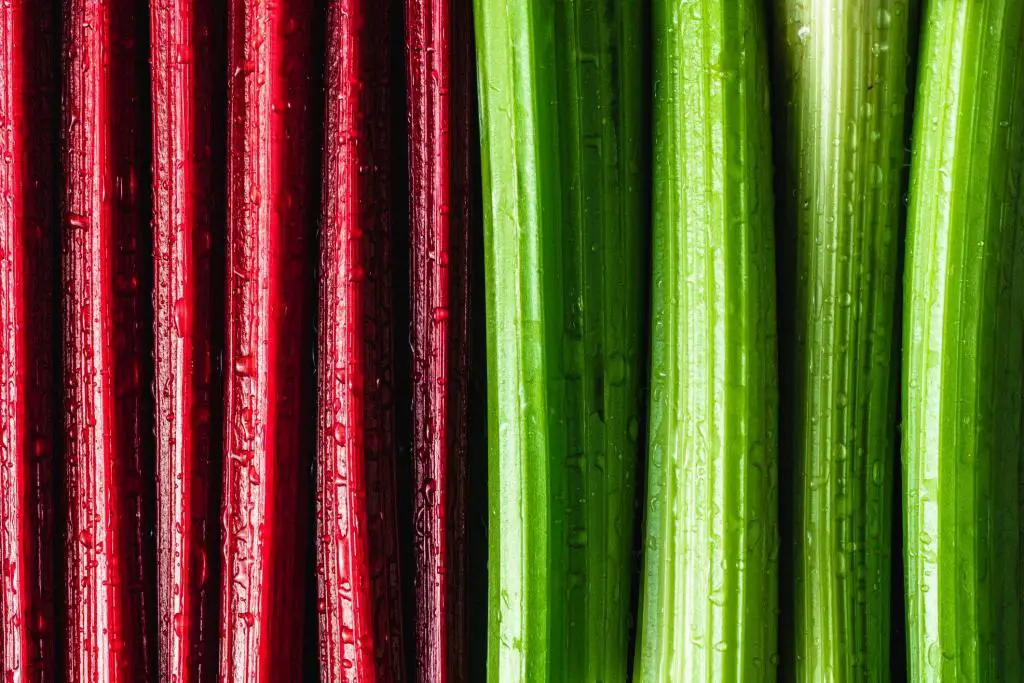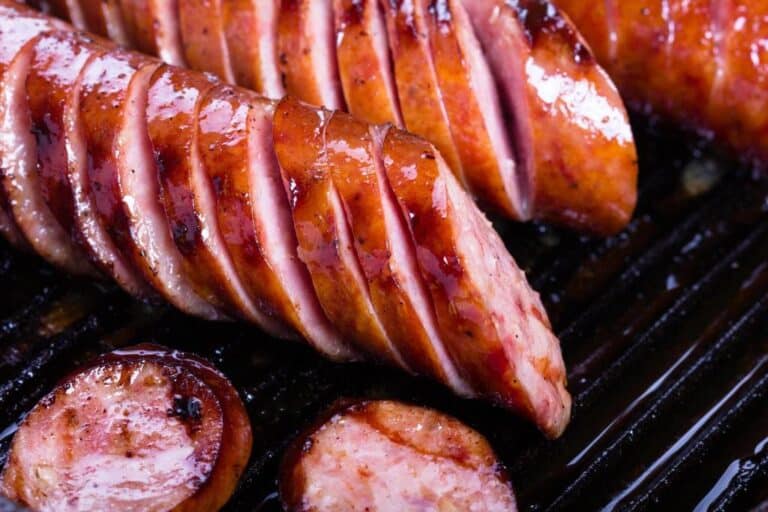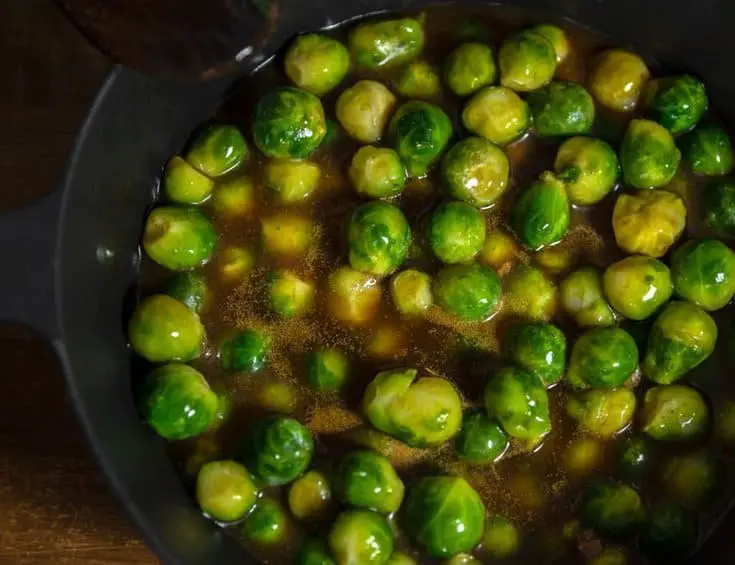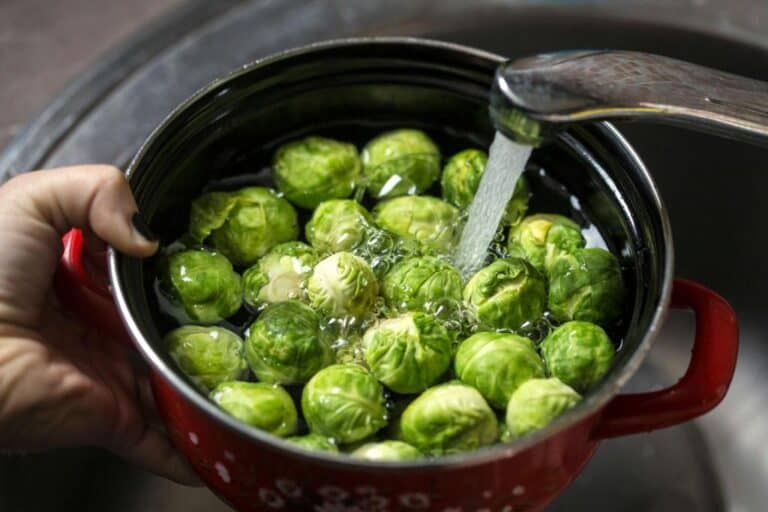How Do You Eat Rhubarb Raw and When Not To Eat Rhubarb?

Rhubarb is a vegetable that is often used in sweet desserts, but did you know that you can also eat it raw? While it may not be the most common way to consume rhubarb, it can be a refreshing and healthy snack option.
Many people assume that rhubarb can only be eaten in cooked form, but this is not the case. There are actually several ways to enjoy raw rhubarb, whether it be in a smoothie, a salad, or simply dipped in sugar. However, there are also some precautions you should take when consuming raw rhubarb, as it contains oxalic acid, which can be harmful in certain amounts.
Next, we will discuss when it is best to avoid eating rhubarb altogether. While rhubarb is generally considered safe for consumption, there are certain times when it is not recommended.
By understanding when it is best to avoid rhubarb, you can safely enjoy this versatile vegetable in all of its forms.
Understanding Rhubarb and Its Appearance
Rhubarb is an interesting vegetable that has a unique appearance that sets it apart from other vegetables. Understanding its appearance can help you identify the different parts of the plant, which, in turn, can help you in preparing and eating it.
The rhubarb plant is tall and leafy, with large green leaves that can grow up to two feet long. The stalks of the rhubarb plant, which are the edible part of rhubarb, are typically long and thin, with a range of colors from light pink to deep red. The stalks are often thicker at the base and become narrower as they extend upward.
One important thing to note about rhubarb is that the leaves are not edible and contain high levels of oxalic acid, which can be toxic. So, it’s important to make sure that you cut off the leaves and discard them before preparing the stalks for consumption. The stalks of rhubarb have a fibrous texture and a tart, tangy flavor that is often used in sweet desserts.
Why Is Rhubarb So Popular?
Rhubarb is a beloved and popular ingredient for many reasons. One reason is that it’s easy to grow and maintain. Rhubarb is a perennial plant that can last for several years if properly cared for. It doesn’t need much care besides being watered regularly and fertilized every so often, and it can grow in a wide range of soils and climates.
Also, rhubarb plants are pretty hardy and resistant to many common garden pests and diseases. This makes them a low-maintenance choice for home gardeners.
Another reason for rhubarb’s popularity is its versatility in cooking. Rhubarb can be used in a wide variety of recipes, from sweet to savory, and can be prepared in many different ways.
It can be baked into pies and tarts, simmered into sauces and jams, or even pickled for a tangy snack. Rhubarb can also be paired with other fruits and ingredients, such as strawberries, ginger, and citrus, to create unique and delicious flavor combinations.
Rhubarb’s health benefits are also a major reason for its popularity. The plant is rich in vitamins, minerals, and antioxidants, which can help boost the immune system and promote overall health.
Rhubarb is also a good source of fiber, which can aid in digestion and help regulate blood sugar levels. Additionally, rhubarb is low in calories and fat, making it a great option for those who are watching their weight.
Can You Eat Raw Rhubarb?
Rhubarb is a unique vegetable that is often used in cooking, particularly in desserts. However, many people wonder if it’s safe to eat raw rhubarb. The answer is yes, you can eat rhubarb raw, but it’s important to keep in mind that the stalks are quite tart and fibrous, so they may not be to everyone’s taste.
When eating raw rhubarb, choose the right stalks. Look for stalks that are firm, brightly colored, and free from blemishes or bruises. The stalks should be trimmed at both ends and washed thoroughly before eating.
To make raw rhubarb more palatable, you can sweeten it with sugar, honey, or maple syrup. You can also add it to salads or fruit bowls to add a tangy crunch. One great way to enjoy raw rhubarb is to dip it in a sweet dip, such as cream cheese or yogurt.
However, it’s important to note that raw rhubarb contains oxalic acid, which can be harmful in large amounts. While eating a small amount of raw rhubarb is unlikely to cause harm, consuming large quantities over time can lead to kidney damage. Therefore, it’s best to enjoy raw rhubarb in moderation and balance it with other healthy foods.
How Do You Eat Rhubarb Raw
Rhubarb is a popular ingredient that is often used in baked goods and cooked dishes, but did you know that it can also be eaten raw? Raw rhubarb has a crunchy texture and a sour, tangy taste that can be quite refreshing.
However, there are a few things you should keep in mind when eating rhubarb raw.
- You should remember that not all parts of the rhubarb plant are safe to eat raw. Particularly dangerous are the leaves, which, if eaten in large amounts, can cause serious health problems. Stick to eating only the stalks, which are the edible part of the plant.
- When preparing raw rhubarb, it’s a good idea to remove the tough outer layer of the stalks. This can be done by peeling them with a vegetable peeler or by simply pulling the fibrous strings away from the stalk.
- Once the outer layer has been removed, the stalks can be sliced into thin, bite-sized pieces and enjoyed as a snack or added to salads for a pop of tart flavor.
- Keep in mind that raw rhubarb can be quite tart, so you may want to add a bit of honey or maple syrup to sweeten things up. To mellow out the tart taste of raw rhubarb, you can dip the stalk into sugar or honey. You can also sprinkle a little granulated sugar or drizzle it with a bit of honey to cut the sourness
- Raw rhubarb can also be used in smoothies and juices for a nutritious and tangy boost. Simply blend the chopped stalks with your favorite fruits and veggies and enjoy!
When Not To Eat Rhubarb?
While rhubarb is a delicious and versatile vegetable, there are some situations where it’s best to avoid eating it.
- One of the main reasons is if you have a history of kidney problems. Rhubarb has a lot of oxalic acid in it, which can cause kidney stones in people who are prone to getting them. If you have a history of kidney stones or other kidney issues, it’s best to avoid eating rhubarb altogether.
- Another situation where you may want to avoid eating rhubarb is if you’re taking certain medications. Rhubarb can make some medicines, like blood thinners and antibiotics, less effective or cause side effects that could be harmful. If you’re taking any medications, it’s always best to check with your healthcare provider before adding rhubarb to your diet.
- Another crucial factor to consider is the time of year. The ideal time to eat rhubarb is before the middle of summer, preferably before the end of July. After this time, the stalks become very fibrous and lose their flavor. You don’t want to ruin a rhubarb dish by using stalks that are past their prime.
- It’s also crucial to pay attention to the quality of the rhubarb before eating it. If the stalks have gone bad, they should not be consumed. Signs of bad rhubarb include rotting, a change in texture, and color. When selecting rhubarb at the grocery store, make sure to choose stalks that are thick, glossy, and stiff to the touch. Avoid any that appear limp or excessively bendy.
- Finally, it’s important to note that the leaves of the rhubarb plant are toxic and should never be eaten. The leaves contain high levels of oxalic acid, which can be deadly in large amounts. If you accidentally eat rhubarb leaves or think someone else has, you should go to the hospital right away.
Can You Eat Rhubarb That Is Not Red?

Yes, you can eat rhubarb that is not red. Although most people associate rhubarb with its bright red color, there are many varieties of rhubarb, and some are actually green or even a mix of red and green.
The amount of sunlight that rhubarb receives while growing determines its color, and some varieties simply produce more green than red stalks. So, the color of the stem is simply an indication of the variety of rhubarb and does not affect its edibility.
While green rhubarb may look less appetizing to some people, it is just as safe to eat as the red variety and has the same tangy flavor. Green rhubarb stems are just as safe to eat as their red counterparts and have a similar flavor profile.
In fact, some people prefer the flavor of green rhubarb because it is less sweet and more tangy. If you are unsure about how to cook with green rhubarb, try using it in a recipe that calls for both rhubarb and strawberries, as the sweetness of the strawberries can balance out the tartness of the rhubarb.
When selecting rhubarb, the color of the stalks should not be the only factor you consider. Look for stalks that are firm and crisp, with no signs of wilting or damage. The leaves of the rhubarb should be removed immediately, as they are toxic and should never be consumed.
Whether you choose red or green rhubarb, be sure to wash it thoroughly and trim off any ends or leaves before cooking or eating. With its unique flavor and versatility, rhubarb can be a delicious addition to your diet, regardless of its color.






